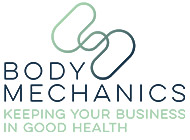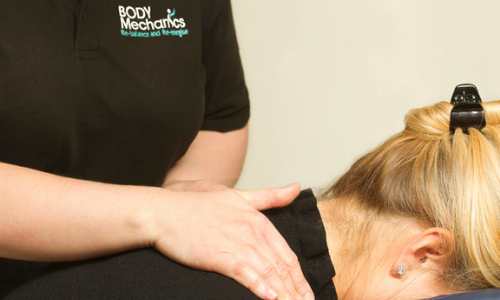Better Body, Better Business
This article first appeared as an interview in Issue 131 of Business Info in June 2017
Business Info talks to Nikki Roy, Director of Body Mechanics Remedial, about whether employers should be doing more to look after employees’ wellbeing.
Employers have a duty of care towards their employees, but with 78% of injuries and illnesses linked directly to the workplace, according to the HSE, are they doing enough?
Nikki Roy, Director of Body Mechanics Remedial, believes not. She argues that were businesses to pay more attention to the health and happiness of workers, they would not only see big benefits to their bottom line, but also help relieve the current crisis in the NHS by reducing musculo-skeletal and stress-related illness.
Feedback from clients of Body Mechanics Remedial Ltd, the company Nikki set up in 2012 after a work-related back injury meant she was unable to continue with her 12-year career in sales and sales management, shows that positive impact that on-site health and wellbeing programmes can have on the health and performance of employees:
- 100% of clients say their programme helps maintain employees’ general health and wellbeing;
- 93% of staff attend regularly;
- 50% use the service to manage stress;
- 22% use it for treatment of a specific injury;
- 87% say it helps their working performance.
Before setting up Body Mechanics, Nikki retrained at St Mary’s University College in Twickenham and became a Massage Therapist, specialising in the treatment of back pain, deep tissue and sports massage. She started out providing massage on company premises, but since then has become more and more involved in developing strategic wellbeing programmes tailored for each client.
Business Info spoke to her about the importance of such programmes and why businesses should take wellbeing seriously.
Business Info: Can you tell me a bit about what you do?
Nikki Roy: We help people lead pain-free lives, but we also help organisations increase their profits by keeping their employees healthy. We go on-site into offices and provide various health and wellbeing programmes depending on clients’ requirements – these could be around physical health, mental health, the work environment itself. We then put together a bespoke programme to help them fulfil their obligations of duty of care to their employees, but also to help them achieve their business goals.
We go on-site into offices and provide various health and wellbeing programmes depending on clients’ requirements
BI: Why do businesses come to you initially?
NR: A high level of sickness absence is a popular reason. They want to reduce absence levels and they want to prevent people getting back into that situation. We take a look at what’s happening in the working environment and what they can do to help people stay healthy in the office.
The other reason is retention – making the company more attractive to the people who work there now, improving their working day by giving them something to look forward to, like nipping out for a massage or going to a yoga or meditation session. It can help them de-stress and then find focus on the job at hand, and it’s nice to be part of an organisation that values you in that way.
BI: How often does a business utilise services such as massage?
NR: It depends entirely on each individual organisation. Some people have us come twice a week to do full days; others only want us in once a month. The most popular option is every two or four weeks, usually around lunchtime or towards the end of the day. We don’t have to be there for a full day.
BI: Who are some of your clients?
NR: We deal with a global e-marketing company; we’ve worked with a couple of charities; we’ve got a big media company; we’ve got a brewery; and we’ve also got a couple of schools.
BI: You’ve mentioned massage and yoga, what other treatments do you offer?
NR: We have Nutritionists, Personal Trainers, Massage Therapists, Psychologists, Pilates Instructors. Body Mechanics has a network of Associate Practitioners and that gives us the option to pick and choose the best people out there and put together a programme that organisations want. It’s not a one-size-fits-all; they get to say who they think would be the best fit for their business culture.
BI: Do you help employers create an all-round strategy for wellbeing?
NR: We’re going that way. When I first set this up that wasn’t necessarily my intention; the main aim was service delivery, but we’re getting more involved with the strategy side of things. Clients want our input into how this works.
BI: What are the benefits of massage?
NR: For workers, it tends to be around alleviating stress, whether emotional, physical or financial – the mind-body connect presents itself in a number of ways; staying healthy; making sure that you’re able to work and feel mentally present.
For employers, it can improve productivity and overall employee engagement. Productivity and quality of engagement tends to go up if people are happier – you know the old adage ‘a happy, workforce is a productive workforce.’ You see people working better as a team, they become more innovative, more creative, and then customer satisfaction and employee satisfaction increase. When that all comes together your bottom line as a business will go up because everybody is working together as a team.
It’s not just about receiving a particular treatment; it’s about having that time out, having a company that cares. I think people then go ‘Well okay. I’m willing to give something back”.
BI: Do you think businesses could be doing more to address the wellbeing of their employees?
NR: Definitely. I think they’re doing the bare minimum. People will do things like ergonomic assessments, they’ll offer private healthcare, subsidised gym membership. But, really, those things are optional or reactive, so there tends to be an issue there already if people are using them. And with the gym, we’ve all been there, you don’t always go as often as you should! But now people are understanding that if they invest in people and if they do it on-site, it keeps them in the workplace, they’re not having to take time off to make doctor appointments, phone calls, childcare etc…
BI: Are health and wellbeing programmes an affordable option for small businesses?
NR: Although this is an investment, a lot of businesses see it as a financial outlay. Research flagged up by the Health Work Wellbeing Executive in a report by PwC shows that for every £1 spent on an employee health and wellbeing programme, £4.17 can be expected back as a benefit. Business is all about the bottom line; senior management want to know figures, and I think that’s a really powerful statistic. If they can make a return on investment that high, and that’s a conservative estimate, then it starts to make business sense.
People tell me they hold their smartphone wedged between their ear and their shoulder, and they’re getting neck problems as a result
BI: People talk about RSI much less than they used to – is it still a problem?
NR: I think it has gone down. In a lot of cases, RSI came down to the use of the mouse and the way the workspace was set up; ergonomic assessments tend to cover that now. I think health and safety are on the ball on that one.
But the thing that comes up time and time again is back pain, rather than RSI – lower back problems if you’re sitting too long or lifting and upper back and neck complaints if you’re at your desk a lot or driving a lot.
BI: How would you treat someone with back problems?
NR: It would depend on what the organisation and individual are open to. When you come in for a massage there’s an assessment and then the best way to move forward with treatment is agreed and carried out. We also offer after-care advice – stretches or movements to help with mobility of the spine or to ease discomfort and pain. We then feed that into the workstation assessment. A lot of people have to carry laptop bags or use laptop trolleys. If you’re doing that a lot, it puts strain on the back, so we’d also look at whether there are other, more body-friendly ways of carrying out your day-to-day activities.
BI: Is the use of smartphones and tablets producing different types of problem?
NR: Yes definitely. And a lot of the time, problems occur out of work. I always hear people say ‘my thumbs really hurt’, which is from texting so much! People also tell me they hold their smartphone wedged between their ear and their shoulder, and they’re getting neck problems as a result. So yes, smartphones and tablets are an issue.
BI: If a business could change one thing today to help their employees’ health, what do you think that should be?
NR: To listen to your employees and ask them the problems they’re facing, because I think a lot of businesses make assumptions and don’t always get it right. It tends to be from senior management; they’re not doing the groundwork so they don’t necessarily understand what those issues are. Have a consultative meeting with your employees and listen to what the issues are.
You can read this article in Business Info Issue 31 here.

